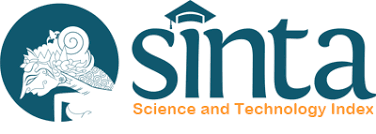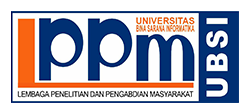Perancangan Aplikasi Analisa Kecenderungan dan Gaya Belajar Menggunakan Metode Learning Style Inventory
Abstract
Full Text:
PDFReferences
D’Amore, A., James, S. and Mitchell, E. K. L. (2012) ‘Learning Style of First-year Undergraduate Nursing and Midwifery Students: A Cross-sectiona Survey Utilising The Kolb Learning Style Inventory’, Elsevier: Nurse Education Today, 32(5), pp. 506–515. doi: 10.1016/j.nedt.2011.08.001. https://www.sciencedirect.com/science/article/abs/pii/S0260691711002000
Fuad, A. J. (2015) ‘Gaya Belajar Kolb dan Percepatan Belajar’, Psyhology Forum UMM: Seminar Psikologi dan Kemanusiaan, pp. 1–6. doi: ISBN: 978-979-796-324-8. http://mpsi.umm.ac.id/files/file/1-6%20A%20Jauhar.pdf
Gogus, A. and Gurdal, E. (2016) ‘Learning and Personal Attributes of University Students in Predicting and Classifying The Learning Styles: Klob’s mine-region Versus four-region Learning Styles.’, Elsevier: Procedia Social and Behavioral Sciences, pp. 779–789. doi: DOI: 10.1016/j.sbspro.2016.02.145. https://www.sciencedirect.com/science/article/pii/S1877042816001701
Istiana, P. (2016) ‘Gaya Belajar Dan Perilaku Digital Native Terhadao Teknologi Digital Dan Perpustakaan’, Prosiding Seminar Nasional SLiMS Commeet West Java 2016, pp. 343–350. https://repository.ugm.ac.id/139214/
Lestari, W. (2015) ‘Pemetaan Gaya Belajar Mahasiswa Dengan Clustering Menggunakan Fuzzy C-Means’, Jurnal Sainstech Politeknik Indonusa Surakarta, 1(3), pp. 1–8. http://www.poltekindonusa.ac.id/wp-content/uploads/2016/05/Vol-1-3-2015-PEMETAAN-GAYA-BELAJAR-MAHASISWA-DENGAN-CLUSTERING-Wiji-L.pdf
Manolis, C., Burns, D. J. and Assudani, R. (2013) ‘Assessing Experiential Learning Style: A Methodological Reconstruction and Validation of The Kolb Learning Style Inventory.’, Elsevier: Learning and Individual Differences, (23), pp. 44–52. doi: 10.1016/j.lindif.2012.10.009. https://www.sciencedirect.com/science/article/pii/S1041608012001495
Nugroho, P. U., Pajow, A. P. and Liem, A. T. (2016) ‘Aplikasi Test Personality dan Learning Style Inventory Berbsis Web Untuk Mahasiswa Universitas Klabat’, Seminar Nasional Teknologi Informasi dan Multimedia, pp. 37–42. https://www.ojs.amikom.ac.id/index.php/semnasteknomedia/article/view/1261
Nurajizah, S. and Saputra, M. (2018) ‘Sistem Pakar Berbasis Android Untuk Diagnosa Penyakit Kulit Kucing Dengan Metode Forward Chaining’, Jurnal Pilar Nusa Mandiri, 14(1), pp. 7–14. http://ejournal.nusamandiri.ac.id/index.php/pilar/article/view/81
Setiawan, M. F. and Prihastuti (2013) ‘Perbedaan Karakteristik Gaya Belajar Guru Ditinjau Dari Mata Pelajaran yang Diampu pada Guru Sekolah Menengah Pertama (SMP) dan Sekolah Menengah Atas (SMA) di Surabaya’, Jurnal Psikologi Pendidikan dan Perkembangan, 2(2), pp. 100–108. http://journal.unair.ac.id/download-fullpapers-jppp514415dfcffull.pdf
Shaikh, A. (2015) ‘Learning Styles and Satisfaction With Educational Activities Among Paediatric Physicians at King Abdulaziz Medical City Jeddah’, Jurnal of Taibah University Medical Sciences, 10, pp. 102–108. doi: 10.1016/j.jtumed.2015.02.002. https://www.sciencedirect.com/science/article/pii/S1658361215000244
DOI: https://doi.org/10.31294/jp.v17i2.5563
Copyright (c) 2019 Perspektif
dipublikasikan oleh LPPM Universitas Bina Sarana Informatika Jakarta
Jl. Kramat Raya No.98, Kwitang, Kec. Senen, Kota Jakarta Pusat, DKI Jakarta 10450

This work is licensed under a Creative Commons Attribution-ShareAlike 4.0 International License









